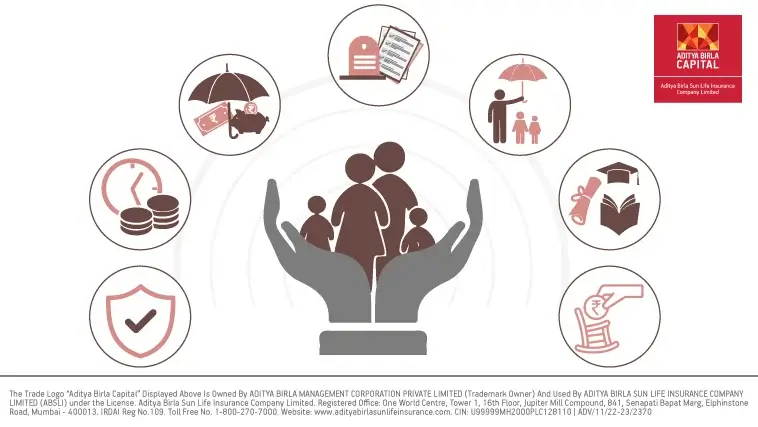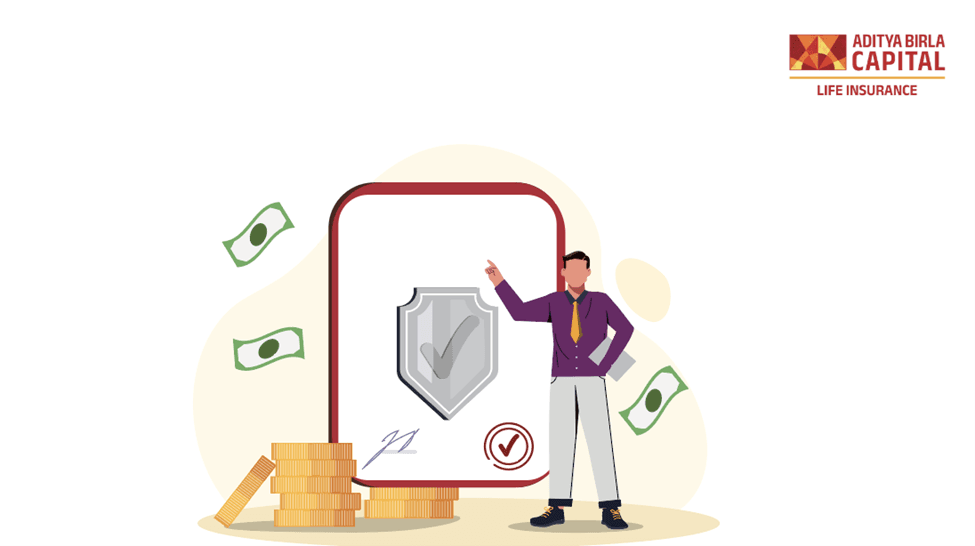Aditya Birla Sun Life Insurance Company Limited
7 Top investment options for the risk-averse investor

Plan Smarter, Live Better!

Thank you for your details. We will reach out to you shortly.

Currently we are facing some issue. Please try after sometime.


- Table of Contents
Investments need to be aligned with your life goals. You've probably heard of it or read it online more times than you can count. But that's not the only thing your portfolio should account for. In fact, your investments should also match your risk profile. This is particularly true if you are a conservative investor.
Conservative investors are typically risk-averse - meaning that they prefer not to take too much risk with their investments. Their primary goal is not so much capital appreciation as it is capital preservation.
To invest according to your risk profile, you need to first figure out if you are a risk-averse investor. And to do that, it is important to first decode what risk is all about.
What is risk in investments?
Risk is the possibility that the value of your investments will decrease - rather than increase - over time. Generally, when you invest your money in an asset or a scheme, the end goal is to remain invested for a given duration and then sell your investments for a higher price than the purchase price. Effectively, this gives you profits. However, if the price of the asset you invest in goes down at the time of selling it, you will have to bear losses.
Some investments are riskier than others. The more the price of an asset fluctuates, the higher the chances are of its price falling. This increases the risk associated with that investment option. However, due to the volatility, the chances of the asset's price increasing significantly are also high. In other words, the risky assets also bear the potential of generating higher returns.
But if you are a conservative investor, you may prefer to invest in assets that give you a guaranteed payout rather than those that may be more volatile - even if it means trading off higher returns in the process.
7 risk averse investments options in 2023
If you identify yourself as a risk-averse investor, here are some investment options that may be ideal for your investment portfolio.
- Public Provident Fund
The Public Provident Fund (PPF) is one of the many safe investment options available for conservative investors. It is a long-term investment scheme backed by the government, and it offers guaranteed, risk-free returns coupled with capital protection, making it one of the best investment options for risk-averse individuals.
You can open a PPF account with as little as Rs. 100. Your account should be opened with a Post Office, with a nationalized bank, or even with certain private banks.
Check out the key features of the Public Provident Fund scheme below.
- The tenure of your PPF investment is 15 years. After this, you can extend the investment period by blocks of 5 years.
- PPF investments earn interest at the rate of 7.10% per annum.
- The minimum annual investment required to keep your account active is Rs. 500.
- The maximum annual investment is Rs. 1.5 lakhs.
- The investments made in PPF are eligible for tax deductions under section 80C, up to Rs. 1.5 lakhs per year.
- National Pension System
The National Pension System is another one of the many low risk investment options in India. Introduced by the Indian government and governed by the Pension Fund Regulatory and Development Authority (PFRDA), this is a voluntary investment scheme for Indian citizens who want to save up for their retirement.
Although a portion of your investment in NPS is directed towards equities, NPS has traditionally offered higher interest rates than other tax-saving investments. There are two main types of NPS accounts, namely Individual NPS accounts and Corporate NPS accounts. In an Individual NPS account, only the account holder can contribute to the investments. But in a Corporate NPS account, both the account holder and their employer can make contributions.
Check out the key features of the National Pension System investment scheme below.
- You can open sub accounts, known as tiers, in NPS. These can be Tier I or Tier II accounts.
- Tier I accounts are the default accounts, and you can open one with a minimum contribution of Rs. 500. The minimum annual contribution required for a Tier I account is Rs. 1,000.
- Tier II accounts are voluntary accounts, and you can open one with a minimum contribution of Rs. 1,000.
- Contributions to your Tier I account are eligible for tax benefits up to Rs. 1.5 lakhs u/s 80C, and up to an additional Rs. 50,000 u/s 80CCD.
- Gold
Gold is widely regarded as a safe haven asset, making it one of the many safe investment options that risk-averse investors turn to when the markets crash. Typically, gold is held as a long-term investment that has the potential to deliver inflation-beating returns over a longer period.
There are different ways in which you can invest in gold in India. Check out your options below.
- Physical gold: Physical gold investments involve buying gold in its physical form, either as jewelry, gold coins or gold bars.
- Digital gold: Digital gold is a method of investing in gold in its virtual form, without the added burden of storing gold physically. The minimum investment value is INR 1.
- Gold mutual funds: Gold mutual funds are simply MFs that invest mainly in gold bullion or in companies that mine gold or produce gold products.
- Gold ETFs: ETFs or Exchange Traded Funds are traded on an exchange, just like stocks are. Gold ETFs track the domestic price of gold and allow you to invest in the yellow metal passively.
- Sovereign Gold Bonds (SGBs): SGBs are securities issued by the Reserve Bank of India that offer assured interest at the rate of 2.5% per annum. Each bond is denominated in grams of gold. The basic unit is 1 gram. SGBs have a tenure of 8 years, with an option to exit from the 5th year onward.
- Debt funds
Debt funds or debt mutual funds are MFs that invest in debt instruments like government bonds, corporate bonds, money market instruments and other fixed income securities. They are among the best investment options for risk-averse investors who seek guaranteed returns or fixed income.
Based on the duration of the mutual fund scheme, debt funds can be any of the following types.
|
Type of fund |
Duration of the scheme |
|
Overnight funds |
1 day |
|
Ultra-short duration funds |
Between 3 and 6 months |
|
Low duration funds |
Between 6 and 12 months |
|
Short duration funds |
Between 1 and 3 years |
|
Medium duration funds |
Between 3 and 4 years |
|
Medium to long duration funds |
Between 4 and 7 years |
|
Long duration funds |
Over 7 years |
-
Dividend stocks A dividend is a portion of a company's profits, which is paid out to its shareholders. Not all companies pay dividends. So, by extension, not all stocks are dividend stocks. Furthermore, some companies may pay dividends as a one-time event, while others periodically pay them out.
So, the long and short of it is that dividend stocks or dividend-yielding stocks are equity shares that pay out dividends to their holders regularly. These stocks carry a higher level of risk than debt-oriented investments, but are not as risky as growth stocks. For risk-averse investors, this can help strike the delicate balance between risk and reward. -
Endowment plans Also known as savings plans, these are life insurance policies that offer the additional advantage of long-term savings. So, if the policyholder survives the policy term, the insurer pays out maturity benefits to the policyholder.
Since these returns are guaranteed# under endowment plans, they make for safe investment options for conservative investors. Furthermore, endowment plans also offer tax benefits2 under the Income Tax Act, 1961 - both to the policyholder and their nominees, as outlined below.
- The premiums paid for the policy are tax-deductible u/s 80C
- The death benefits are tax-free in the hands of the nominee u/s 10(10D)
- The maturity benefits are tax-free in the hands of the policyholder u/s 10(10D)
- Fixed deposits
No list of safe investment options is complete without a mention of fixed deposits. Considered to be the original safe haven scheme, FDs have been popular for several generations now. The returns from a fixed deposit are guaranteed, and you can choose to reinvest the interest earned, or to receive it as periodic and regular payouts.
Check out the key features of fixed deposits below.
- The investment tenure for an FD varies from one bank to another, and can range from around 7 days to 10 years or more.
- The returns of an FD investment are compounded on a periodic basis, which may be monthly, quarterly, or annually.
- Senior citizens generally receive interest at a rate that is marginally higher, typically by 0.50%.
- There are tax-saver FDs that offer tax benefits. They have a lock-in period of 5 years, and the amount invested in these FDs is tax-deductible up to Rs. 1.5 lakhs u/s 80C.
Conclusion
This concludes our list of the top low risk investment options for investors who wish to keep their portfolio risk to the minimum. If you belong to that category of investors, keep in mind that you can also reduce your portfolio risk by diversifying your investments. And if you want to earn higher returns over the long run, it may be necessary to take on some level of investment risk.
How much should you ideally invest every month?
Choosing the right investment options is one half of the picture. Aside from that, you also need to figure out how much you should invest in the options you've selected. Not sure how you can go about doing this? Well, we have a blog that can help you out with this.
WANT TO ENJOY A SIZABLE COVER WITH MINIMAL RISK AND AFFORDABLE PREMIUMS?
If you answered yes to this question, the ABSLI DigiShield Plan can help you out. This term insurance plan offers you comprehensive coverage at pocket-friendly premiums. You can choose from around 10 plan options, based on your individual needs and your family's requirements.
But that's not all. Depending on the plan option you choose, you can also customize your policy and pay your premiums as a one-time amount or at periodic intervals that are convenient for you.
Plus, you get the advantage of terminal illness benefits, enhanced life stage protection, tax benefits2, rider1 options and so much more!
Thanks for reaching out. We will reach out to you shortly.
Thanks for reaching out. Currently we are facing some issue.
Get immediate income payout after 1 day of policy issuance^
ABSLI Nishchit Aayush Plan
Guaranteed# Income
Life Cover across policy term
Lumpsum Benefit at policy maturity.
Get:
₹33.74 lakhs~
Pay:
₹10K/month for 10 years
Most Popular Calculator
Guaranteed returns after a month¹
1 Riders offer additional benefits that are not included in the base policy at a nominal additional premium. There are exclusions attached to the riders. Please refer prospectus for more details.
2Tax benefits are subject to changes in tax laws. Kindly consult your financial advisor for more details.
ADV/4/22-23/55







